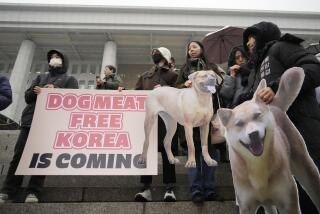Japan Outlaws Feeding of Bone Meal to Cattle
- Share via
TOKYO — Amid fears of a nationwide outbreak of “mad cow” disease, Japan’s Ministry of Agriculture, Forestry and Fisheries announced Tuesday that feeding bone meal to cattle is now against the law.
The decision followed the revelation late last week that a Japanese meat-processing plant had ground up the carcass of the first cow in the country suspected of having the bovine disease and begun selling it as fertilizer and feed for chicken and pigs.
That news fueled worries of an epidemic because several of the three dozen cattle raised on the island of Hokkaido along with the suspect 5-year-old dairy cow were slaughtered or shipped elsewhere in Japan and cannot be checked for the disease. Formally known as bovine spongiform encephalopathy, or BSE, the disease was first detected in Britain in the mid-1980s.
Later Tuesday in Washington, the U.S. Agriculture Department said it had tightened import restrictions on Japanese meat because of similar concerns. The U.S. already maintains a ban on live cattle and beef from Japan that it imposed in March 2000 after an outbreak of foot-and-mouth disease here.
A potentially fatal human variant of mad cow, Creutzfeldt-Jakob disease, has been linked to meat and bones from cattle infected with BSE that are recycled back into cattle feed. Britain has banned the use of recycled cattle products in livestock feed for more than a decade, as has much of the European Union.
As of Tuesday, some of the 150 tons of processed animal protein that might have been contaminated with the remains of the suspect cow had been sold by the meat-processing plant to another wholesaler. That portion is now contained in two warehouses.
But it was only through the wholesaler, Tokushima Kasei Business Corp., that the Agriculture Ministry learned of the possible contamination of the bone meal, officials said at a news conference.
The company noticed that the date and place of origin of the bone meal matched when and where the suspect cow was processed. It contacted prefectural officials for advice.
The cow had caught the attention of investigators Aug. 6, when government inspectors, who randomly check cattle before they are slaughtered at the nation’s 145 processing plants, noticed that the animal was not standing properly.
Initial tests indicated a positive diagnosis of BSE, although Japanese regulators are awaiting confirmation from testing being done in Britain.
The Agriculture Ministry ordered the processing company and the wholesaler to stop shipping the animal feed. A spokesman for the ministry’s animal feed division said “maybe we will move toward burning it” if it is determined to have been processed after Aug. 6.
The ministry has recommended since 1996 that farmers not feed bone meal to cattle, but Japan continued to import feed containing animal proteins until January, even from the EU, where the disease has shown up in France, Italy, Belgium and several other countries.
Such products will still be allowed for poultry and pigs, even farm-raised fish. A ministry official said that the U.S. and Australia also give animal protein feed to chicken and pigs and that it doesn’t cause mad cow disease.
The difference, said Etienne Reuter, an EU spokesman in Tokyo, is that the U.S. and Australia haven’t had any mad cow cases yet, while Japan apparently has.
“We’re able to share our experience,” Reuter said. “We remember the initial complacency in Europe. They said, ‘Don’t panic.’ And a number of things were not done immediately to limit the impact. We prefer to err on the side of caution.”
Since April, 260 Japanese cows have shown indications of nerve problems, the Agriculture Ministry said. It isn’t clear what happened to them. Unlike the EU, which burns diseased cows, Japan has no facilities to incinerate cattle, which can weigh more than a ton, according to farmer Yoshiyuki Moki.
In fact, farmers with sick cattle have an incentive to have them ground up for feed or fertilizer, said Moki, who owns a farm in Chiba, near Tokyo. That way, he said, at least a farmer will be able to earn enough to cover the costs of transporting and disposing of a diseased animal.
Though ingredients are listed on the containers of feed bought by farmers, there’s no easy way to determine whether the feed includes animal protein, Moki said, beyond trusting the suppliers. He noted that Japanese crave very high-fat milk, which fetches higher prices, and only four or five years ago, protein-based feed was touted as helping produce such milk.
Shabu Zen, an upscale restaurant chain that serves the beef dish shabu shabu, seemed more upset with a reporter who inquired about the safety of Japanese beef than with the notion that contaminated feed might have been introduced into the food chain.
“We’re definitely safe because we’re using beef from Tohoku,” insisted the chain’s manager, who gave only his last name, Hirata. He was referring to the northern part of Japan’s main island of Honshu, as opposed to the Tokyo area, where the suspect cow was processed.
“The news didn’t affect our business at all,” he said.
*
Makiko Inoue of The Times’ Tokyo Bureau contributed to this report.
More to Read
Sign up for Essential California
The most important California stories and recommendations in your inbox every morning.
You may occasionally receive promotional content from the Los Angeles Times.













